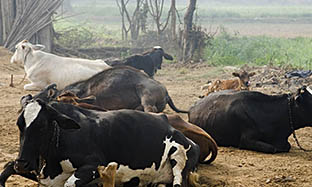 (1).jpg)
Calf diarrhea: the causes of this disease
In cattle breeding, neonatal diarrhea can cause severe economic losses, due to the high mortality rate, treatment costs, and the possible stunting that accompany it.
Several infectious agents are responsible for diarrhea and can coexist, or even succeed each other on the same calf, which complicates their precise identification.
-
Bacteria: it is essentially Escherichia coli, but we can also find bacteria of the genus Salmonella, Clostridium, Yersinia or Campylobacter.
-
Viruses: these are mainly rotavirus, coronavirus and BVD. Togoviruses and caliciviruses are also sometimes isolated.
-
Parasites: such as Cryptosporidium parvum, Eimeria sp., Giardia sp., Strongyloides sp. Cryptosporidia are the most frequently identified parasites.
To these infectious causes, we can add food causes, related to a milk content too high in fat, or to drinks too high in volume or too low in temperature. Diarrhea linked to food is white in colour and has a plastery texture. The calf is a little or not dehydrated at all, but by weakening the calf, they can promote the appearance of infectious of parasitic diarrhea.
The occurrence of enteritis in young calves results from a combination of risk factors. Prevention therefore requires the control of these factors.
Control of colostral intake
Even though the immune system of calves is functional from birth, active immune protection only takes place after several weeks. The transfer of passive immunity by colostrum is therefore an essential step, which must take place during the first hours of life. A new-born calf absorbs antibodies via colostrum, that are supposed to protect him against infectious agents that cause diarrhea: however, it is common for a calf to have insufficient protection against these agents, either because the amount of colostrum ingested is insufficient, or because the colostrum is of poor quality. Vaccinating mothers during pregnancy against neonatal diarrhea agants improves the quality of colostrum, specifically against these agents.
Hygiene measures
The hygiene of the calving and accommodation premises plays a major role in the infectious pressure, as well as the cohabitation between calves of different ages, the older animals excreting germs likely to contaminate the younger ones. A good solution for dairy calves is the use of individual niches for the first weeks of life, which avoid excessive spread of germs, especially with newborn calves that are most fragile.
Ration and food control
Mothers’ diets, especially in the last third of gestation, are crucial for calf health. The nutritional balance between energy and nitrogen content must be optimal; special attention will also be paid to supplementation with macro and trace elements, and vitamins.

